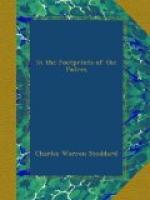On the day following, Monday, James King of William died. On Tuesday Casey was tried by the executive committee. John S. Hittell, the historian of San Francisco, says:
“No person was present at the trial save the accused, the members of the Vigilance Committee, and witnesses. The testimony was given under oath, though there was no lawful authority for its administration. Hearsay testimony was excluded; the general rules of evidence observed in the courts were adopted: the accused heard all the witnesses, cross-examined those against him, summoned such as he wanted in his favor, had an attorney to assist him, and was permitted to make an argument by himself or his attorney, in his own defence.”
Casey and Cora were both convicted: their guilt was beyond the shadow of a doubt.
On Wednesday James King of William was laid to rest at Lone Mountain. The whole city was draped in mourning; all business was suspended; the citizens lined the streets through which the feral cortege proceeded, or followed it until it seemed interminable.
As that procession passed up Montgomery Street and crossed Sacramento Street, those who were walking or driving in it looked down the latter street and saw, two squares below, the lifeless bodies of James P. Casey and Charles Cora dangling by the neck from two second-story windows of the headquarters of the Vigilance Committee. Justice was enthroned at last.
“The Vigilance Committees of San Francisco in 1851 and 1856,” as Hittell says, “were in many important respects unlike any other extra-judicial movement to administer justice. They were not common mobs: they were organized for weeks or months of labor, deliberate in their movements, careful to keep records of their proceedings, strictly attentive to the rules of evidence and the penalties for crime accepted by civilized nations; confident of their power, and of their justification by public opinion; and not afraid of taking the public responsibility of their acts.”
The committee of 1856 was never formally dissolved. The reformation it had accomplished rendered it inactive. Some of the worst criminals in California had been officials. A thousand homicides had been committed in the city between 1849 and 1856, and there were but seven executions in seven years.
Richard Henry Dana, Jr., the author of “Two Years before the Mast,” who spent the greater portion of two years—1834-35—on the coast of California, and who revisited the Pacific coast in 1859, observes:
“And now the most quiet and well-governed city in the United States is San Francisco. But it has been through its seasons of heaven-defying crime and violence and blood; from which it was rescued and handed back to soberness and morality and good government by that peculiar invention of Anglo-Saxon republican America—the solemn, awe-inspiring Vigilance Committee of the most grave and respectable citizens; the last resort of the thinking and the good, taken only when vice, fraud, and ruffianism had entrenched themselves behind the forms of law, suffrage, and ballot.”




